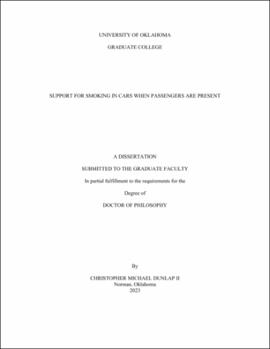| dc.description.abstract | Background: Smoke-free policies protect people in the US from exposure to secondhand smoke in public spaces and the workplace, but fewer protections exist for non-smokers in private cars. This dissertation examined demographic, regulatory, and occupational characteristics associated with support for and against smoking being allowed inside cars when others and children, specifically, were present. Methods: Data derived from 128,835 participants in the 2018-19 wave of the Tobacco Use Supplement to the Current Population Survey (TUS-CPS). For each manuscript, multinomial logistic regressions were conducted using SAS 9.4 to analyze characteristics associated with thinking that smoking should “never,” “under some conditions,” and “always” be allowed in a car. Models were calculated separately for participant responses to two items asking about smoking in cars “when others are present” and “when children are present”, with “never allowed” as the referent response for smoking in cars. Results: Manuscript I: Those who identified as White, male, non-Hispanic, and everyday smokers were more likely to indicate that smoking should be allowed in cars under some conditions or always when others and when children were present. Manuscript II: Characteristics of those who were more likely to indicate that smoking should be allowed in cars under some conditions or always when others including children were present included living in a state which restricted smoking in cars when children under age 12 were present, not having a smoke free rule in their home, and indicating that smoking should be allowed in multiunit housing, recreational areas like bars and clubs, and indoor work areas. Manuscript III: Among those who were currently employed, those exposed to smoke at their place of work were more likely to think smoking should under some conditions and always be allowed in cars when others and when children were present. Conclusions: This dissertation identified specific characteristics linked to indicating that smoking in cars should be allowed. This project also provides guidance on specific populations who are at higher risk of thinking smoking in a car is acceptable. | en_US |

